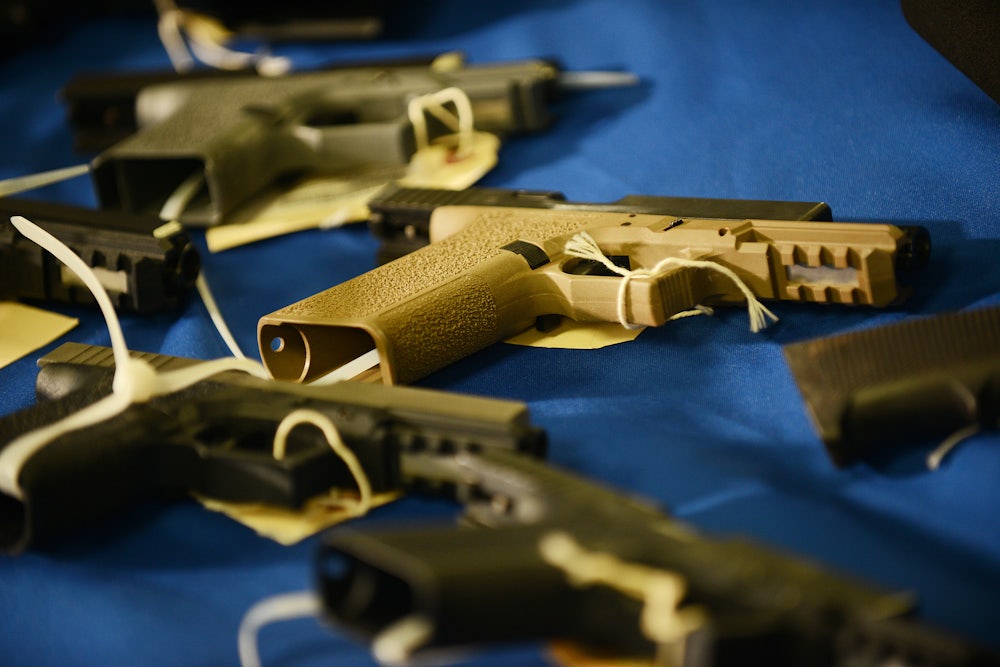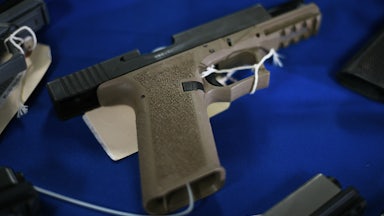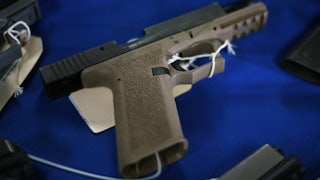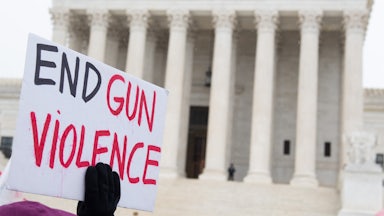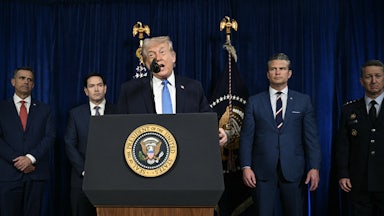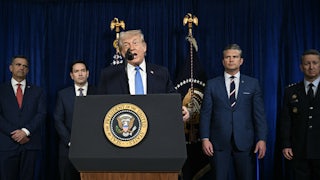The Supreme Court signaled again this week that it would allow the federal government to regulate so-called “ghost guns,” despite legal challenges. In an unsigned order on Tuesday, the justices blocked a lower court ruling that had prevented a rule by the Bureau of Alcohol, Tobacco, Firearms and Explosives targeting prefabricated gun-building kits from going into effect. The move cements a significant setback for gun rights advocates who hoped the high court might be more favorable toward the kits.
Court watchers have closely monitored how the justices will tackle gun-related cases in general in recent years. Unlike most areas of the law, the court is often breaking new ground when it involves itself in gun-related cases. Thanks to the court’s rightward shift—as well as a recent ruling that created a new test for Second Amendment challenges—few legal issues are in as much flux before the court as this one.
Unlike most gun cases that reach the court, however, Vanderstok v. Garland is not a Second Amendment case. The plaintiffs instead asked the court to examine whether the ATF had correctly interpreted the Gun Control Act of 1968, or GCA, for its ghost-gun rule. The ATF issued a rule in 2022 that the GCA’s definition of a firearm “shall include a weapon parts kit that is designed to or may readily be completed, assembled, restored, or otherwise converted to expel a projectile by the action of an explosive.” The Biden administration hailed the change as a step in cracking down on ghost guns.
“Ghost guns” is the colloquial name for homemade guns built from prefabricated kits. In the modern era, firearms are typically manufactured by commercial gunmakers and then sold intact to consumers. Federal law requires that every gun sold in the United States, with the exception of certain antique firearms, includes a serial number so that its ownership history can be tracked. Those numbers aren’t found on ghost guns, typically by design. Technological advances and the advent of the internet have made such kits more popular in recent years.
Since ghost guns aren’t sold through the usual channels, they can evade most federal restrictions on gun purchases. “Some manufacturers of those products assert that they are not ‘firearms’ regulated by federal law, and thus can be sold without serial numbers, transfer records, or background checks,” the Justice Department told the court in its motion for a stay. “Those features of ghost guns make them uniquely attractive to criminals and others who are legally prohibited from buying firearms or intend to use them to commit crime.”
Shortly after the new ATF rule was issued, gun rights groups mounted legal challenges to it. One of those challenges, brought by a coalition of gun owners and advocacy groups, found its way to the courtroom of Judge Reed O’Connor in the Northern District of Texas. They argued that the ATF had gone beyond what Congress had authorized by defining the “frame or receiver” of a gun under the GCA to include the parts that could be used to construct a frame or receiver.
“Congress never understood itself to be adopting language permitting every actual or potential part of a firearm be regulated as a firearm itself through the GCA,” the plaintiffs argued. “Congress also did not give the agencies the authority to regulate the broad array of materials that may, at some point in the future, be manufactured into firearms by private individuals. Individuals that are not otherwise prohibited from possessing firearms in the United States are free to personally manufacture firearms—there is no federal law that allows the executive branch to regulate or prohibit that practice.”
The Justice Department, for its part, argued that its reading fit well within the statute’s text and reflected its overall purpose. It noted that technological advances have changed how guns are designed and manufactured, justifying the new definition for frames and receivers. And they pointed out that the ATF has long regulated nonfunctional frames and receivers under the premise that they could easily be made functional and fashioned into a working firearm.
“Under any other approach, persons could easily circumvent the requirements of the GCA and [the National Firearms Act, or NFA] by producing or purchasing almost-complete frames or receivers that could easily be altered to produce a functional frame or receiver,” the government argued in its brief for the district court, quoting from Supreme Court precedent. “This would thwart Congress’s purpose in enacting the GCA and NFA to ‘ensure that weapons [are] distributed through regular channels and in a traceable manner,’ thus making ‘possible the prevention of sales to undesirable customers and the detection of the origin of particular firearms.’”
O’Connor was a lucky draw for a presiding judge for the plaintiffs. He has earned a national reputation for favoring unconventional arguments by conservative lawyers and interest groups. This approach has led him to strike down the Affordable Care Act as unconstitutional on multiple occasions, each based on a reason less credible than the last, and most recently to try to strike down the Indian Child Welfare Act on erroneous grounds. When the Fifth Circuit Court of Appeals hasn’t already done so, the Supreme Court has consistently overturned his highest-profile rulings.
In June, O’Connor sided with the gun rights groups. He noted that the GCA “covers ‘any weapon’ that is ‘designed to’ or ‘may readily be converted to’ fire a projectile.” Then he concluded that this phrasing does not cover ghost-gun kits that are designed to be built by consumers into functional firearms. “But Congress’s definition does not cover weapon parts, or aggregations of weapon parts, regardless of whether the parts may be readily assembled into something that may fire a projectile,” he wrote.
In fairness to O’Connor, he does note that some portions of the GCA explicitly apply more broadly to weapon parts than the one in question here. And the National Firearms Act, the GCA’s predecessor law, also had language covering weapons parts in general that was not echoed in the GCA itself. But he also acknowledged that an observer might find his ruling—that ghost-gun kits designed to be fashioned into a gun by a layperson to evade background checks and recordkeeping don’t count as guns—seemed nonsensical. If that’s the case, he reasoned, it’s actually Congress’s fault.
“Defendants contend that drawing such a distinction will produce the absurd result whereby a person lawfully prohibited from possessing a firearm can obtain the necessary components and, given advances in technology, self-manufacture a firearm with relative ease and efficiency,” O’Connor wrote. “Even if it is true that such an interpretation creates loopholes that as a policy matter should be avoided, it [is] not the role of the judiciary to correct them. That is up to Congress. And until Congress enacts a different statute, the Court is bound to enforce the law as written.”
Tuesday’s decision is technically the second time that the court has intervened in this case so far. In August, the Supreme Court agreed to lift a nationwide injunction that had blocked the federal government from enforcing the ATF rule while litigation worked its way through the courts. This motion involved a narrower injunction against the two ghost-gun kit makers that had intervened in the lawsuit.
The August decision all but telegraphed the court’s current divide on the issue: Justices Clarence Thomas, Samuel Alito, Neil Gorsuch, and Brett Kavanaugh all indicated that they would have voted to keep the injunction intact. While the justices are not obligated to disclose their votes in these cases, the four dissenters effectively disclosed that the majority consisted of Chief Justice John Roberts, Justice Amy Coney Barrett, and the court’s three liberals.
Roberts is widely believed to be a more moderate voice on gun-related issues. His apparent reticence to take up Second Amendment cases would explain a decade-long silence on the court after its landmark ruling in District of Columbia v. Heller in 2008, which established an individual right to bear arms in the Second Amendment for the first time. And while he voted with the majority in the New York State Rifle and Pistol Association v. Bruen decision last year, he also joined Kavanaugh’s concurring opinion that reaffirmed the constitutionality of a wide range of gun restrictions.
Though Vanderstok is not a Second Amendment case, the court’s handling of it on the shadow docket could mean that the court’s conservative majority isn’t in lockstep on future gun-related cases. It also raises the stakes for the court’s oral arguments later this term in United States v. Rahimi, a post-Bruen case on gun possession for people under domestic violence protective orders. If Roberts, Barrett, and/or Kavanaugh are also skeptical of the lower courts’ ruling in that case, the court may be heading back to its gun-shy ways when it comes to criminal enforcement.
